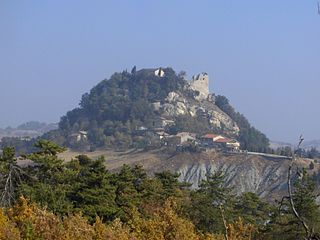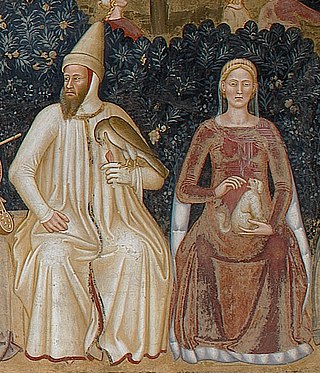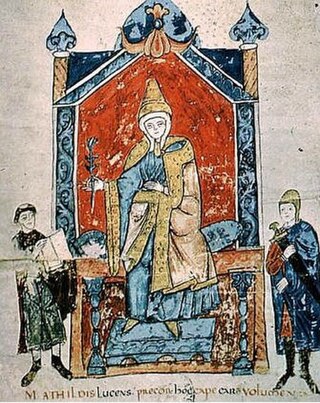Related Research Articles

Matilda of Tuscany, also referred to as la Gran Contessa, was a member of the House of Canossa in the second half of the eleventh century. Matilda was one of the most important governing figures of the Italian Middle Ages. She reigned in a period of constant battles, political intrigues and Roman-Catholic excommunications, and was able to demonstrate an innate and skilled strategic leadership capacity in both military and diplomatic matters.

Eupraxia Vsevolodovna of Kiev was a Holy Roman Empress consort. She was the daughter of Vsevolod I, Grand Prince of Kiev, and his wife Anna Polovetskaya, daughter of a Cuman khan. She married Henry IV of Germany in 1089 and took the name Adelaide.

Boniface III, son of Tedald of Canossa and the father of Matilda of Tuscany, was the most powerful north Italian prince of his age. By inheritance he was count of Brescia, Canossa, Ferrara, Florence, Lucca, Mantua, Modena, Pisa, Pistoia, Parma, Reggio, and Verona from 1007 and, by appointment, margrave of Tuscany from 1027 until his assassination in 1052.

Beatrice of Bar was the marchioness of Tuscany by marriage to Boniface III of Tuscany, and Regent of Tuscany from 1052 until her death, during the minority of and in co-regency with, her daughter Matilda. She was the daughter of Frederick II, Duke of Upper Lorraine, count of Bar, and Matilda of Swabia. She was married first to Boniface III of Tuscany and later to Godfrey of Lotharingia.
Michèle Kahn Spike is an American lawyer, historian, and lecturer. She graduated from Boston University School of Law in 1976 and became a member of the Bar of the State of New York in 1977, concentrating in international corporate law. From the late 1980s until 2011, she lived in Florence, Italy together with her husband, art historian John Spike. Since fall 2012 she has been teaching at the Marshall-Wythe School of Law at the College of William & Mary, and she was appointed as Visiting Professor of the Practice of Law in 2017.

Ansa or Ansia was a Queen of the Lombards by marriage to Desiderius (756–774), King of the Lombards.

Canossa is a comune and castle town in the Province of Reggio Emilia, Emilia-Romagna, northern Italy. It is where Holy Roman Emperor Henry IV did penance in 1077 and stood three days bare-headed in the snow to reverse his excommunication by Pope Gregory VII. The Walk to Canossa is sometimes used as a symbol of the changing relationship between the medieval Church and State.

Magdalena di Canossa was an Italian professed religious and foundress of the two Canossian congregations. Magdalena was a leading advocate for the poor in her region after she witnessed first hand the plight of the poor following the spillover effects of the French Revolution into the Italian peninsula through the Napoleonic invasion of the northern territories. Canossa collaborated with humanitarians such as Leopoldina Naudet and Antonio Rosmini in her mission of promoting the needs of the poor and setting a new method of religious life for both men and women.
Arduin Glaber was count of Auriate from c. 935, count of Turin from c. 941/942, and Margrave of Turin from c. 950/964. He placed his dynasty, the Arduinici, on a firm foundation and established the march of Turin through conquests and royal concessions. The Chronicon Novaliciense, the chronicle of the abbey of Novalesa, is the primary source for his life.

Adelaide of Turin was the countess of part of the March of Ivrea and the marchioness of Turin in Northwestern Italy from 1034 to her death. She was the last of the Arduinici. She is sometimes compared to her second cousin and close contemporary, Matilda of Tuscany.

The March of Tuscany was a march of the Kingdom of Italy and the Holy Roman Empire during the Middle Ages. Located in northwestern central Italy, it bordered the Papal States to the south, the Ligurian Sea to the west and Lombardy to the north. It comprised a collection of counties, largely in the valley of the Arno River, originally centered on Lucca.

Bernardo degli Uberti was an Italian Roman Catholic prelate who was a professed member and served as an abbot of the Vallumbrosan Order. Uberti served as the Bishop of Parma from 1106 until his death and was appointed as a cardinal. He came from the noble Uberti house from Florence. Uberti served as a papal legate for successive popes in several Italian regions in their disputes with secular rulers and was a close confidant and advisor to the Countess Matilda. He is often considered the third founding father for the order alongside Benedict of Nursia and Giovanni Gualberto.

Beatrice Regina della Scala was Lady of Milan by marriage to Bernabò Visconti, Lord of Milan, and politically active as the adviser of her spouse.

The Abbey of San Benedetto in Polirone is a large complex of Benedictine order monastic buildings, including a church and cloisters, located in the town of San Benedetto Po, Province of Mantua, Region of Lombardy, Italy. The complex, now belonging to the city, houses offices, a museum, and is open to visitors.

The Bevilacqua dynasty governed parts of Northern Italy between the 10th and 12th centuries. Their rise to prominence began in 962 when Otto I the Great, the first Holy Roman Emperor, appointed Antonio Bevilacqua as Governor of Lazise. The family remained loyal to the Emperors until they later allied themselves with Matilda of Tuscany; they were granted a Principality at Bevilacqua in 1059, and acquired other territories in the areas of Verona and Ferrara. During the 12th-century conflicts between the Guelphs and Ghibellines, the Bevilacqua led the victorious Ghibellines of Verona. They later supported the Canossa family of the Lombard League against Frederick Barbarossa, and in recognition received the church of San Salvaro in Verona.

Donizo of Canossa, was an Italian monk and author in the late eleventh and early twelfth centuries. His work is an important source on Matilda of Tuscany and her dynasty, and also on Gregorian Reform and the Investiture Controversy more generally.
Giselbert II was the count of Bergamo. He was a member of the dynasty known to historians as the Giselbertiners.

Matilda of Swabia, a member of the Conradine dynasty, was Duchess of Carinthia by her first marriage with Duke Conrad I and Duchess of Upper Lorraine by her second marriage to Duke Frederick II. She played an active role in promoting her son, Duke Conrad the Younger, as a candidate for the German throne in 1024 and to this end corresponded with King Mieszko II Lambert of Poland.

Roland of Parma was an Italian cleric during the Investiture Controversy. He took the side of the Holy Roman Empire and served as the bishop of Treviso from 1073/1078 until 1089/1096.
The Battle of Volta Mantovana was fought on the 15th of October 1080 between troops raised by the schismatic bishops of Lombardy loyal to the emperor Henry IV and to anti-pope Guibert of Ravenna against forces commanded by Matilda of Tuscany. Margravine Matilda was defeated and the pro-Imperial forces gained the upper hand.
References
- Donizo of Canossa, Vita Mathildis in Donizonis Vita Mathildis, ed. L. Bethmann, MGH SS 12 (Hannover, 1856), pp. 348–409, accessible online at: Monumenta Germaniae Historica (in Latin)
- Anonymous, Vita di S. Simeoni eremita in P. Golinelli, ed., ‘La Vita di S. Simeoni eremita,’ Studi medievali 3rd ser. XX/2 (1979), 745-788. (in Latin and Italian)
- N. Duff, Matilda of Tuscany: La Gran Donna d'Italia (London, 1909)
- F. Menant, ‘Les Giselbertins, comtes du comté de Bergame et comtes palatins,’ in Formazione e strutture dei ceti dominanti nel medioevo (1988), pp. 115–186.
- J. Jarnut, Bergamo 568-1098. Verfassungs-, Sozial- und Wirtschaftsgeschichte einer lombardischen Stadt im Mittelalter (Wiesbaden, 1977).
- P. Golinelli, Matilde e i Canossa (Milan, 2004).